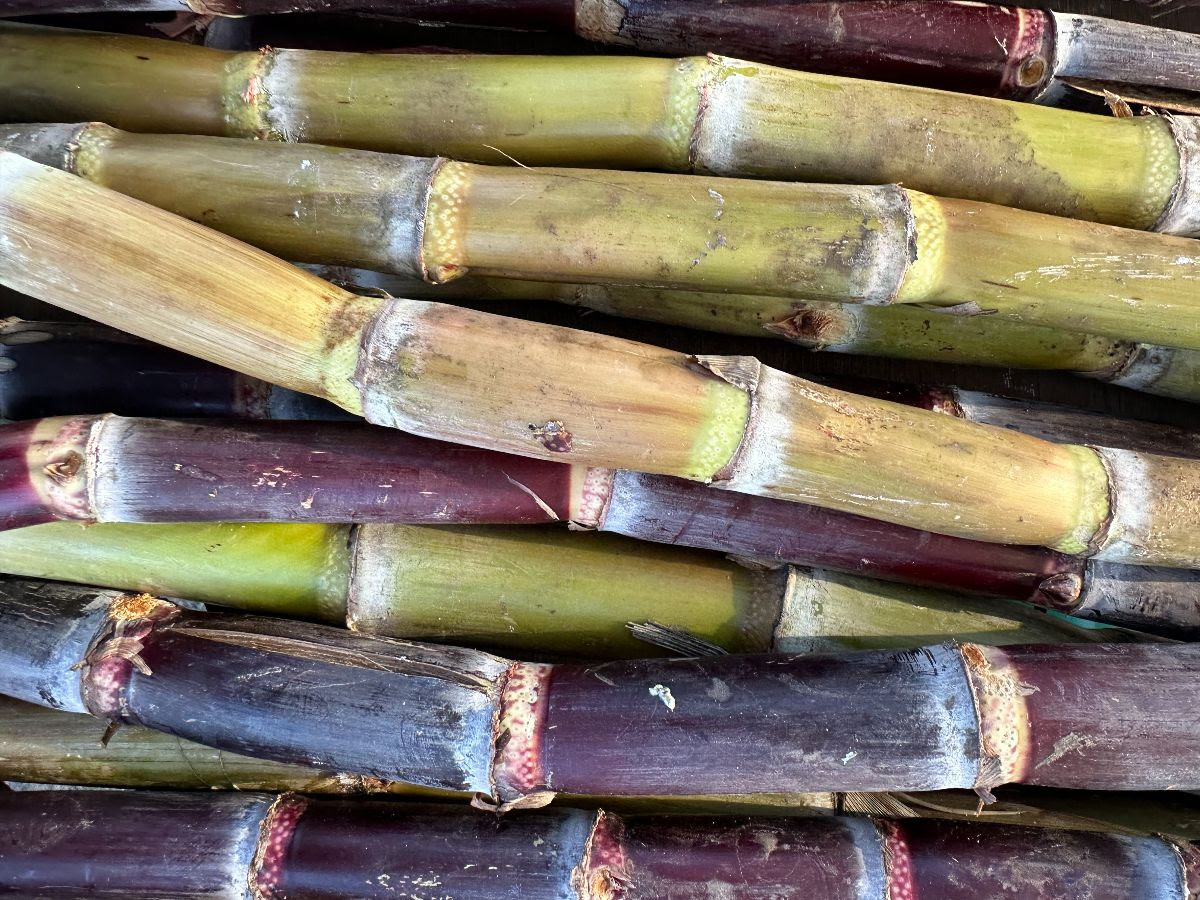WE HAVE SUGAR CANE! I was so incredibly excited to see this at our market, as sugar cane is one of my favorite treats. It’s a tall, tropical grass native to Southeast Asia and the South Pacific. It has been cultivated for centuries for its high sugar content, stored in its thick, fibrous stalks. Sugar cane has played a major role in global trade, particularly during the colonial era, when plantations in the Caribbean, South America, and the southern United States fueled the sugar industry. Today, Brazil, India, and Thailand are among the largest producers. It’s not a super common plant for our area, so it’s extra special that some of our vendors have it!
Sugar cane is primarily used to produce sugar, molasses, rum, and ethanol. Fresh sugar cane juice is popular in many countries, offering a naturally sweet and refreshing drink. My favorite way to eat it is to just chew on it, as pressing it into juice requires special equipment. It can be an intimidating thing to prepare, since the exterior is incredibly tough to cut through. We don’t want you feeling too intimidated to try it though, so we’ve put together a little instructional manual for accessing the sweet juicy goodness of sugar cane:
What You’ll Need:
✔️ A sharp knife or machete (for thick stalks)
✔️ A cutting board
✔️ A paring knife (optional, for fine trimming)
✔️ A mallet (optional, for breaking tough sections)
Step-by-Step Instructions
1. Select and Prepare the Sugar Cane
- Choose a fresh stalk that feels firm and has a smooth, unblemished surface.
- Rinse the stalk under running water to remove any dirt.
2. Trim the Ends
- Place the sugar cane horizontally on a sturdy cutting board.
- Using a sharp knife or machete, cut off about 1–2 inches from both ends where the stalk is dry or discolored.
3. Cut into Manageable Sections
- Sugar cane stalks are long and fibrous, making them difficult to peel whole.
- Cut the stalk into 4–6 inch segments to make peeling easier.
4. Score the Outer Skin
- Stand a segment upright on the cutting board.
- Using your knife, make a vertical cut down one side of the stalk, just deep enough to slice through the tough outer layer.
- Repeat this step on 2–3 sides to create loosening points.
5. Peel Away the Bark
- Use the tip of your knife to lift and pry the tough outer skin away from the cane.
- You can also use your fingers to grip and pull the bark off in strips.
- If the bark is stubborn, slide the knife underneath and gently separate it from the soft, juicy interior.
6. Trim Any Leftover Fibers
- Use a paring knife to remove any remaining fibrous bits clinging to the peeled cane.
- Rinse the peeled sections to remove debris.
7. Ready for Use!
- Your sugar cane is now ready to chew, juice, or cook with!
Tips for Easier Peeling:
✅ Use a cleaver or heavy knife for thick stalks to get better leverage.
✅ Soften the outer skin by soaking the stalk in water for 10 minutes before peeling.
✅ For easier handling, hold the sugar cane firmly with one hand while peeling downward with the knife.

Now that you have the tools you need to get into your sugar cane, here are some ideas for things you can do with your sugar cane:
Enjoy Fresh Sugar Cane
- Chew the Stalk: Cut into small sections and chew to extract the sweet juice, then spit out the fibrous pulp.
- Snack on Sugar Cane Sticks: Cut into thin, bite-sized sticks for a natural, refreshing treat.
Make Sugar Cane Juice
- Method 1: Blender Method
- Cut peeled sugar cane into small chunks.
- Add to a blender with a little water and blend.
- Strain the juice through a cheesecloth or fine sieve.
- Serve chilled with ice, lime, or ginger for extra flavor.
- Method 2: Traditional Press Method
- Use a sugar cane press (available in some markets) to extract fresh juice.
Uses for Sugar Cane Juice:
✔️ Drink fresh, over ice
✔️ Use in cocktails (like mojitos or caipirinhas)
✔️ Mix into lemonade or iced tea
Ferment for Alcohol or Vinegar
- Make Sugar Cane Wine or Rum: Ferment the juice with yeast to create alcohol.
- Sugar Cane Vinegar: Let the juice ferment naturally into vinegar, perfect for dressings and marinades.
Use in Herbal Remedies & Tea
- Boil sugar cane with ginger, lemon, and cinnamon to make a warming tea.
- Some cultures use sugar cane juice as a remedy for sore throats or dehydration.
Craft & DIY Uses
- Make Natural Drinking Straws: Hollow out small sugar cane sections to use as eco-friendly straws.
- Use for Decoration: Dried sugar cane stalks make beautiful rustic décor.
- Compost the Pulp: After juicing, use the leftover fiber as compost or animal feed.
